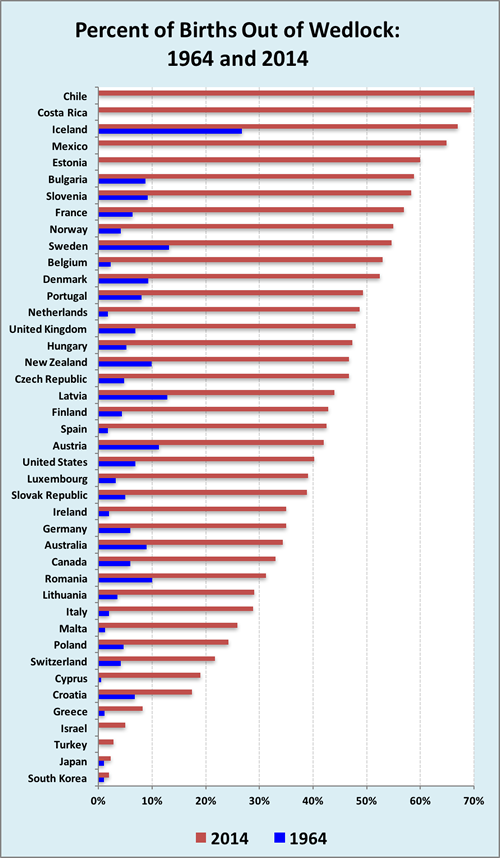Culturally, Asians have strong familial ties and sense of honor and shame. In the US, the out of wedlock rate for Asians is 17%, less than any other racial group.
Since 1970, out-of-wedlock birth rates have soared. In 1965, 24 percent of black infants and 3.1 percent of white infants were born to single mothers. By 1990 the rates had risen to 64 percent for black infants, 18 percent for whites.
Yale study: Out-of-Wedlock Births Rise Worldwide
Of the world’s 140 million births that happened in 2016, about 15 percent - or 21 million – were born out of wedlock. This global average, however, does not reflect the enormous variation in the proportion of births outside of marriage across countries and regions.
At one extreme are some 25 countries, including China, India and most countries in North Africa and Western and Southern Asia, where the proportion of births out of wedlock is low, typically less than 1 percent. In those societies births outside of marriage carry strong social disapproval, including sanctions, penalties and punishments to the mother and father as well as stigmatization of the child. Some travel guides advise couples to pretend to be married.
In striking contrast, the proportions of births outside marriage in another 25 countries mostly in Latin America, including Brazil, Chile, Costa Rica, Jamaica, Mexico and Colombia, are estimated at more than 60 percent. In another 20 countries, including Belgium, Denmark, France, Norway and Sweden, the majority of births occur outside marriage, with government assistance typically provided to single mothers.
Marriage has become less necessary for women’s financial survival, social interaction and personal wellbeing, and government policies have been slow to keep pace. Like it or not, out-of-wedlock births are in transition worldwide and create challenges for many societies. Increasingly single women and cohabiting couples, especially in Western societies, elect to have children and raise them outside the institution of marriage. In many countries, marriage is no longer viewed as the only acceptable institution for childbearing and long-term intimate relationships.
The high incidence of childbearing out of wedlock is a relatively recent phenomenon. The proportions of such births a half century ago were substantially lower than today. For example, in 1964 most countries in the Organisation of Economic and Co-operative Development had no more than 10 percent of their births outside of marriage. By 2014 in only five countries – Greece, Israel, Japan, South Korea and Turkey – were the proportions of births out of wedlock below 10 percent. In the large majority of more developed countries, including Germany, the United Kingdom and the United States, more than one-third of all births take place out of wedlock.

Many of the children born out of wedlock live in single-parent households, typically headed by single mothers. The proportions of children living in single-parent households vary considerably across countries. At the lowest levels where 10 percent or less of the children live in single-parent families are three dozen mainly developing countries, including China, India, Indonesia, Israel, Jordan and Turkey.
And high levels of single-parent families are found in Latin Africa countries where close to 40 percent of the children live with mothers only and about 4 percent live with fathers only. Other countries with high levels of children in sole-parent households – typically a single mother – include Mozambique, 36 percent; Dominican Republic, 35 percent; Liberia, 31 percent; and Kenya, 30 percent.
Over the past several decades the incidence of single-parent families has generally increased worldwide, with the largest increases in industrialized countries. Between 1980 and 2005, for example, the proportion of single-parent households doubled for many developed countries, including France, Japan, Sweden, the United Kingdom and the United States.
Note, a woman having a non-marital birth does not necessarily translate into a single-parent household. Often non-marital births occur to cohabiting couples, who increasingly choose to continue cohabiting rather than marry.
Among OECD countries, children (infants to age 17) living with two cohabiting parents are increasingly common. While the average OECD proportion of children living with two married parents declined from 72 to 67 percent between 2005 and 2014, the proportion living with cohabiting parents increased from 10 to 15 percent over that decade.
The highest proportions are observed in five countries – Estonia, France, Iceland, Slovenia and Sweden – where one quarter of the children are living with cohabiting parents. And in Austria, Canada, Denmark, Hungary, the United Kingdom and the United States, more than one fifth of the children live with a sole parent, which substantially exceeds the proportion of children with cohabiting parents.
